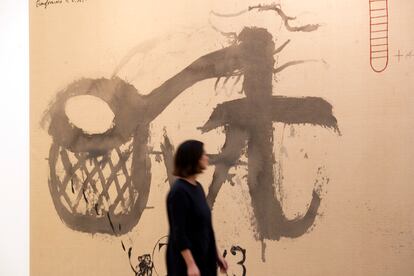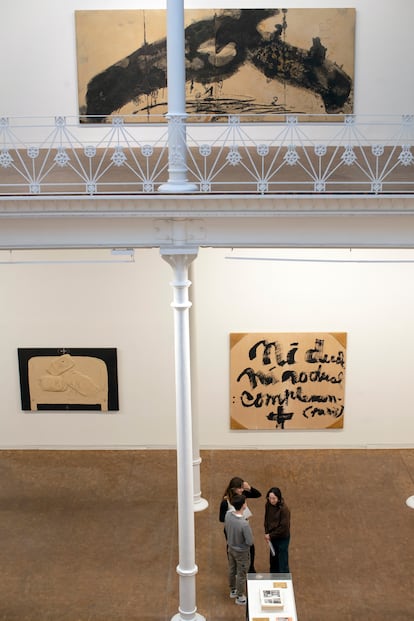‘Long live Tàpies’: Buddhism, art and science to celebrate Antoni Tàpies’s centennial
The creator’s foundation kicks off a year of homage with exhibitions and acts that will explore his relationship with spirituality and his work, in dialogue with other artists, such as writer Irene Solà and photographer John Baldessari

“In light of the teachings of Chan, all daily activities … from the way one cooks and eats to our organism’s activities that are considered the most innoble — everything is made sacred, transformed, and positioned at its rightful worth.” This phrase by Catalan artist Antoni Tápies is the framing for Tàpies. La huella del zen [Tàpies. The Zen footprint], one of the two exhibitions that kick off the Año Tàpies [Tàpies Year]: a program featuring exhibitions, publications, events and creative activities that touch on the artist’s relevance, on the 100th anniversary of his birth.
Antoni Tàpies (Barcelona, 1923-2012) was an experimental artist who largely focused on painting and sculpture, and who is consecrated as one of the great figures of the contemporary world due to his technical, material and conceptual innovations in art. His trajectory — which integrates disciplines like writing, film and philosophy — was marked by his defense of art as a tool for reflection on the human condition.
“I don’t know what Tàpies would think of the conflict in Palestine, but I am sure that he would say something,” says Inmaculada Prieto, director of the foundation. Año Tàpies goes beyond his plastic legacy to address the current relevance of his work, from an approach that integrates all the disciplines and issues to which he dedicated his life, such as environmentalism, culture and language, social policies, human rights and topics such as mysticism and spirituality.
Under the motto “Tàpies lives. Long live Tàpies,” the foundation that bears his name will become the event’s nerve center on Wednesday, with an open house that includes workshops of the reading of Antoni Tàpies’s book Memoria personal. Fragmento para una autobiografía [Personal memory. Fragment for an autobiography]. The inaugural action kicks off at 7 p.m. Throughout the centennial, the Antoni Tàpies Foundation will host five exhibitions, two of which are opening on Wednesday.
The first, Tàpies. The Zen footprint, curated by Núria Homs, takes on the artist’s interest in the work of some Japanese monks, from whom he adopted the teachings of Zen Buddhism. As have many contemporary artists, Tàpies incorporated into his language Oriental images, techniques and philosophies as a way of questioning Occidental dominance after the terror of the Second World War. The show includes a selection of paintings, ceramics and drawings — some of which have never been show in public — that reflect his own interpretation of the iconic works of monks such as Hakuin.

Taking on his own interdisciplinary perspective, Año Tàpies focuses on the binomial of art and science, which was fundamental for the artist. The exhibition A = A, B = B, directed by Pep Vidal, brings into the present the lectures by scientists that were collected in the book La nueva vision del mundo [The new vision of the world]. It integrates works from such varied artists as the writer Irene Solà, who recorded her roommate thinking about her childhood in Canada to evoke the inaccessibility of memory; and Throwing Three Balls in the Air to Get a Straight Line, in which John Baldessari photographed various attempts at lining up three balls in the air, combining the artistic and scientific exercise of experiment with observation. One of the rooms of the exhibition, the laboratory, will include scientific works by a student group from the Autonomous University of Barcelona.
Over the course of the year, the Tàpies Foundation will organize a multitude of events distributed between diverse locations to reach viewers and weave a network of alliances with other cultural and artistic institutions and agents, in the hopes of deepening the artist’s legacy. Some of the principal planned activities are directed towards the investigation of art and thought, as is the Antoni Tàpies-UPF Chair and the Teresa Barba critical writing contest, directed towards the student public.
December will see the start of two public programming cycles, which viewers will be able to enjoy throughout the centennial, like Las sillas de Tàpies [Tàpies’s chairs], a multidisciplinary action cycle that has to do with the voice and word in oral memory (which will take place every Friday at the foundation) and the Hoy es Tàpies [Today is Tàpies] cycle, with monthly intergenerational and interdisciplinary talks moderated by the journalist Rita Roig.
The celebration will arrive at the very creative practice of the artist, as in the exhibition Tàpies a través de la palabra [Tàpies through the word], on the influence that writing had on the artist, which will be shown in various Barcelona libraries, and La maleta de Tàpies [Tàpies’s suitcase], a show in which Catalan Superior School of Music students will interpret musical classics that inspired the artist in front of his works, and will take place this Wednesday in Parliament.
Sign up for our weekly newsletter to get more English-language news coverage from EL PAÍS USA Edition
Tu suscripción se está usando en otro dispositivo
¿Quieres añadir otro usuario a tu suscripción?
Si continúas leyendo en este dispositivo, no se podrá leer en el otro.
FlechaTu suscripción se está usando en otro dispositivo y solo puedes acceder a EL PAÍS desde un dispositivo a la vez.
Si quieres compartir tu cuenta, cambia tu suscripción a la modalidad Premium, así podrás añadir otro usuario. Cada uno accederá con su propia cuenta de email, lo que os permitirá personalizar vuestra experiencia en EL PAÍS.
¿Tienes una suscripción de empresa? Accede aquí para contratar más cuentas.
En el caso de no saber quién está usando tu cuenta, te recomendamos cambiar tu contraseña aquí.
Si decides continuar compartiendo tu cuenta, este mensaje se mostrará en tu dispositivo y en el de la otra persona que está usando tu cuenta de forma indefinida, afectando a tu experiencia de lectura. Puedes consultar aquí los términos y condiciones de la suscripción digital.
More information
Archived In
Últimas noticias
Mexico seeks to shore up its defenses following US incursion in Venezuela
Hope gives way to uncertainty among Venezuelan exiles in the US after Maduro’s capture
Cubans look to Venezuela fearfully after Trump’s incursion: ‘We could be next’
The operation in Venezuela to capture Maduro threatens to widen the cracks in the MAGA movement
Most viewed
- Alain Aspect, Nobel laureate in physics: ‘Einstein was so smart that he would have had to recognize quantum entanglement’
- Gilles Lipovetsky: ‘If you want to live better and fall in love, take Prozac, don’t look to philosophy’
- Alvin Hellerstein, a 92-year-old judge appointed by Bill Clinton, to preside over Maduro’s trial in New York
- Cuba confirms death of 32 of its citizens in the US attack against Venezuela
- Why oil has been at the center of Venezuela-US conflicts for decades











































